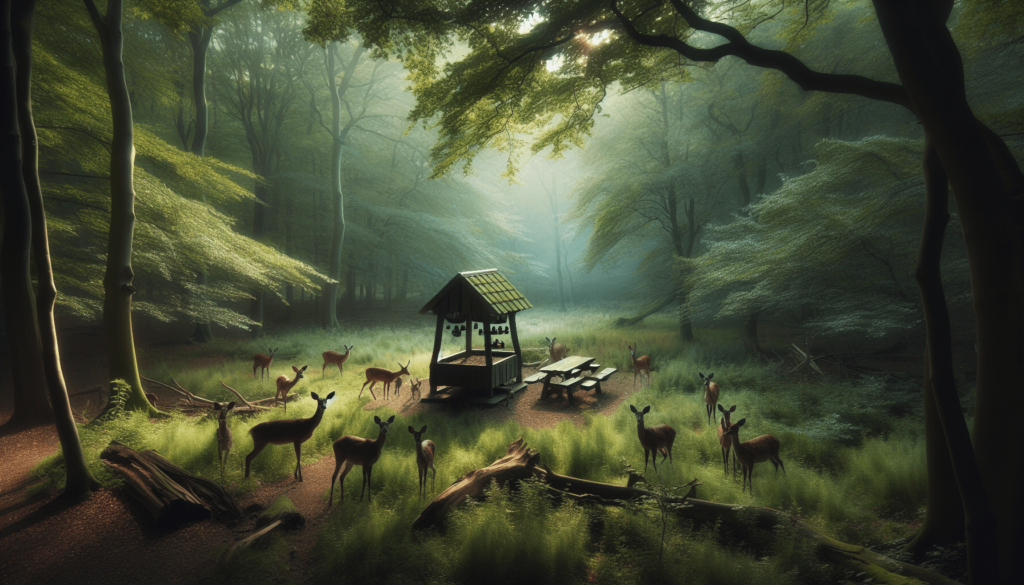
Have you ever wondered how to attract deer consistently, creating a stunning display of nature right in your backyard? Setting up a deer feeding routine can be a rewarding experience, as it provides not just a spectacle for you to enjoy but also a chance to support local wildlife. With a little patience and commitment, you can establish a rhythm that draws these graceful creatures closer to your home, enriching your relationship with nature.

Understanding Deer Behavior
Before you can establish a feeding routine, it’s essential to understand deer behavior. These creatures are naturally cautious, and their feeding habits are influenced by factors such as their surroundings, the time of year, and available food sources.
The Social Structure of Deer
Deer are social animals, often forming herds, especially in females. Understanding the social dynamics can help you tailor your feeding routine. The presence of does and their fawns can attract bucks, especially during the rutting season. Knowing when deer are most active can give you a better idea of when to set your feeding schedule.
Seasonal Changes and Feeding Patterns
Deer feeding patterns change with the seasons. In spring and summer, they tend to graze on tender shoots and foliage, while fall and winter often require a more strategic approach to feed. By adjusting your feeding routine according to seasonal changes, you can maintain consistent visits.
Creating a Feeding Schedule
Now that you understand deer behavior, it’s time to put that knowledge to work by creating an effective feeding schedule. Deer are creatures of habit, so consistency is key to establishing reliable visits.
Choosing the Right Time
Timing is everything. Deer are crepuscular, meaning they are most active during dawn and dusk. By feeding them during these times, you increase the likelihood of attracting them. Experiment with different times to find what works best in your area.
Frequency of Feedings
How often should you feed the deer? A good rule of thumb is to provide food at least a few times a week. This regularity helps to establish a routine, encouraging deer to return. However, be mindful of the local regulations regarding feeding deer, as some states have restrictions you need to follow.
Selecting the Right Feed
Choosing the right feed is crucial for the health of the deer and for making your feeding efforts more effective. Different feeds offer various benefits, so it’s vital to select options that will attract deer while providing them with the nutrients they need.
Types of Deer Feed
There are several types of deer feeds that you can consider. Here’s a breakdown:
| Type of Feed | Description | Benefits |
|---|---|---|
| Grains | Corn, oats, and barley are popular choices. | High energy source, easy to find, inexpensive. |
| Protein Pellets | Specially formulated pellets designed for deer. | Boosts nutritional intake, especially during growth. |
| Fruits and Vegetables | Apples, carrots, and sweet potatoes can attract deer. | Natural sweetness draws deer in, provides vitamins. |
| Browse | Natural branch and leaf material from shrubs and trees. | Natural food source, encourages natural browsing. |
Nutritional Considerations
When selecting feed, consider the nutritional needs of deer. During the spring and summer, they require higher protein to support growth. In contrast, during the cold months, they need energy-rich foods to help sustain their body heat. The right feed can make a significant difference in the health of the deer visiting your area.
Choosing the Right Location
Finding the perfect location for your feeding station is essential for attracting deer consistently. Deer are likely to return to areas where they feel safe and comfortable.
Factors to Consider
When choosing the location for feeding, think about:
- Cover: Deer prefer areas that offer cover, such as trees or dense brush. This provides them security from predators.
- Distance from Human Activity: Set up your feeding station away from high human traffic areas to create a sense of safety for the deer.
- Access to Water: If possible, situate your feeding station near a water source, as deer need to stay hydrated.
Experimenting with Locations
Feel free to experiment with several locations to see where deer are most likely to visit. Landscape features and neighboring environments can significantly impact their feeding behaviors.
Maintaining a Clean Feeding Area
A clean feeding area is crucial for the health of both the deer and the surrounding environment. As inviting as a feeding station can be, neglecting cleanliness can lead to potential health issues for the animals.
Cleaning Strategy
- Remove Old Feed: Regularly check the area and remove any leftover feed to prevent spoilage and mold growth.
- Sanitize Feeding Equipment: If you’re using feeders or buckets, clean them periodically to limit disease transmission.
- Monitor for Waste: Keep an eye out for any signs of fecal matter or other waste, as this can attract unwanted pests and diseases.
Observing and Enjoying the Visits
Once you’ve set up everything, it’s time to sit back and enjoy observing the deer. Watching them feed can be a serene and grounding experience.
Take Notes
Keep a journal or notes about your observations. Tracking which deer visit, their behavior, and feeding preferences can deepen your understanding and connection with them. It can also help you make adjustments to your routine for even better results.
Consider Photography
If you’re a photography enthusiast or just want to capture moments with these lovely creatures, make sure to have your camera handy. Try to be as unobtrusive as possible to avoid startling them, allowing you to capture stunning images of them in their natural state.

Leveraging Technology for Better Feeding Practices
Many tools and technologies can enhance your deer feeding experience. From automatic feeders to game cameras, these options provide convenience and valuable insight.
Automatic Feeders
Consider investing in automatic feeders that dispense food at set intervals. This ensures that deer have access to food even when you’re not around and keeps the routine consistent.
Game Cameras
Setting up game cameras can help you learn more about deer habits. You can monitor times of day when they visit and observe behavioral patterns without disturbing them.
Understanding the Impact of Feeding on Deer Health
While it’s lovely to see deer visit regularly, it’s crucial to understand how feeding can impact their health. Your goal should be to support local wildlife without causing dependency.
Pros and Cons of Deer Feeding
| Pros | Cons |
|---|---|
| Provides supplemental nutrients | Can lead to dependency on human-provided food. |
| Encourages local wildlife observation | May attract unwanted pests or predators. |
| Can help during harsh winters | Overcrowding can result in increased disease spread. |
Responsible Feeding Practices
To ensure that you’re promoting the health of your local deer population, adhere to responsible feeding practices. This includes:
- Limiting Feed Amounts: Don’t overfeed; check local guidelines for quantity recommendations.
- Dispersing Feeding Locations: If possible, spread out feed locations to avoid attracting large groups that can lead to health problems.
- Youth and Health Checks: If you notice sick or injured deer, contact local wildlife authorities for guidance.
Legal and Ethical Considerations
Before setting up your deer feeding routine, it’s important to educate yourself about any legal regulations. Many areas have laws governing deer feeding due to the potential impact on wildlife and the ecosystem.
Research Local Regulations
Be sure to check the rules in your area regarding deer feeding. Some regions strictly regulate or even prohibit feeding to prevent health risks such as the spread of Chronic Wasting Disease. Informing yourself helps protect both your local deer population and yourself from legal repercussions.
Ethical Considerations
Beyond laws, it’s also essential to consider the ethical implications of feeding wildlife. Reflect on questions like whether your actions might inadvertently harm the deer or create an unhealthy reliance on artificial food sources. Make ethical choices rooted in responsibility and respect for nature.
Recipient of Community Engagement
Attracting wildlife to your property can often create a sense of community lending a shared appreciation for nature. Once you establish your deer feeding routine, consider sharing your experiences with neighbors and friends.
Start a Neighborhood Deer-Watching Group
You might find others with the same interest in deer. Starting a neighborhood deer-watching group allows you to exchange tips and experiences while enjoying the beauty of these animals together.
Educational Opportunities
Engaging with your community isn’t just about enjoying the visits. It’s a chance to educate others, particularly children, about wildlife conservation and appreciating the natural world. Organizing informal gatherings can foster awareness and create a sense of stewardship.
Adapting to Changes in the Deer Population
As you implement your feeding routine, you may notice fluctuations in the deer population in your area. Understanding how to adapt is key to maintaining a positive experience.
Factors Influencing Deer Population
The local deer population can be affected by several factors, including:
- Predation: Natural predators may reduce the number of visiting deer.
- Seasons: Migratory patterns and seasonal changes can lead to temporary shifts in numbers.
- Local Management Practices: Wildlife management programs may impact herd sizes.
Adjusting Your Feeding Routine
When you notice changes in deer activity, adjust your feeding strategy accordingly. If the population increases, consider spreading the feed over a wider area. If the numbers dwindle, look for signs of health or behavior issues and adapt as needed.
Celebrating the Seasons with Deer Observations
This journey of establishing a deer feeding routine can become a beautiful seasonal celebration. Each season brings unique opportunities for observation and joy.
Seasonal Changes
- Spring: Witness newborn fawns, a heartwarming and delicate time.
- Summer: Watch young bucks grow their antlers, a natural wonder.
- Fall: Experience the mating season, full of fascinating behaviors.
- Winter: See how they adapt and survive the cold, often seeking extra help from your feed.
Creating Seasonal Traditions
Consider creating traditions around the deer observation experience. Perhaps you could host seasonal gatherings, tracking the changes in deer over the months, or document your observations through photos or notes. Such rituals can strengthen your connection to nature and create lasting memories.
Conclusion
Establishing a deer feeding routine for consistent visits is a deeply enriching experience, allowing you to foster a connection with nature and its gentle inhabitants. By understanding deer behavior, creating a mindful feeding schedule, and maintaining ethical practices, you can support local wildlife while enjoying the beauty of deer in your own space.
As you embark on this journey, remember to be patient and observant. The more you learn about these creatures and their habits, the more rewarding your experience will be. So, prepare to watch quietly—nature is about to unfold a story right before your eyes, one that you can witness in its entirety through thoughtful and dedicated feeding practices. Your backyard can become a stage for the enchanting play of the deer, inviting you to become a part of their world.





